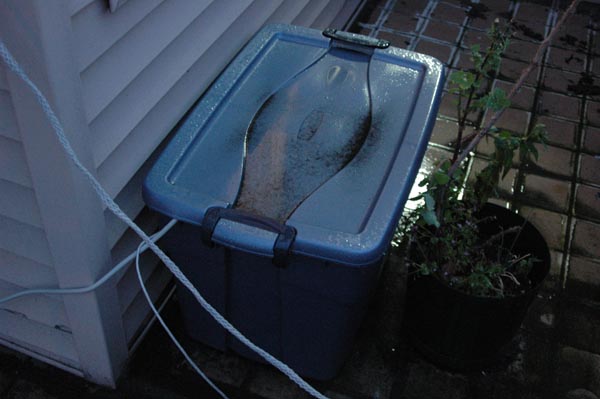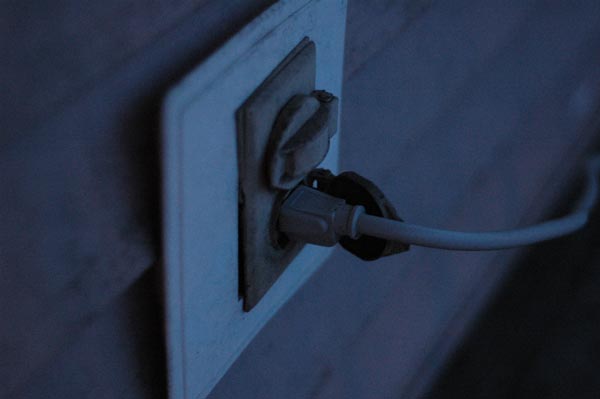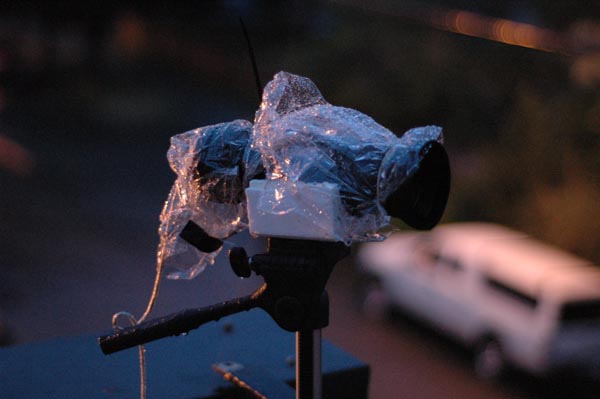Rainier Cam - behind the scenes
The Rainier Nordwand Cam shows a view of Mt Rainier from Seattle,
about 60 miles away.
Setting up a webcam is more work than I had hoped. If you have a view
of something from inside your home, then its easy. If you need to have
the webcam outside and don't want to drill holes in your walls, it is not.
A wireless network is a relatively inexpensive solution if you have a
spare computer lying around.
This is the illustrious webcam server:

The plastic box sits out in the rain
and contains a "barebones" 2Ghz AMD machine with a wireless card.
(no keyboard, mouse or monitor). I administer it from my inside computer.
My balcony has a roof on half of it,
but that half receives a lot sun, and I was afraid the computer would overheat,
so I've moved it to the north side where is bears the full brunt of the
elements. So far so good.
The cord on the right goes to the
webcam. The cord on the left is the power cord. The other thing is a
rope. The potted plant was a Devils Club, but it
died (brown stick) and now there are random weeds growing in it.
The most difficult part of the whole system is power delivery. This is due
to the sketchy outlet:

Power will turn off if you breathe on this plug, because it is very
carefully balanced in the socket. The ground pin doesn't go in very far
(I think it isn't actually connected to anything) and this means the plug
just doesn't go all the way in the socket.
Reliability would be
improved if I put an object under the plug to ensure it doesn't "fall down".
The camera. It is an Orange Micro I-Bot, which is about the only USB2.0 webcam.
Webcams tend to generate video, not still images. This means image quality is
directly dependent on the connection speed. Regular "low speed" USB webcams
need to compress the image to get it across at 15 frames/s or whatever framerate
they use. So that means poor image quality (yes - even poorer that what you're
seeing)! Therefore a USB2.0 webcam has a much better image.
I suppose a cheap digicam that could upload a single image at a time
would be a much better alternative, but you need to power that somehow.

The webcam has its little lens removed and is glued to a rear lens cover that has a hole drilled out of it.
The lens cover is attached to a cheap used 35mm camera lens (focal length is
200mm I think). A Hoya 72 infrared filter (lets in mostly near-infrared light, not visible)
is mounted on the lens, in an attempt to reduce the haze which is common in
the mornings. I'm not sure how useful this is, but there are times the webcam is showing
something, but I can't actually see the mountain. It's also what makes the tree white.
Absolutely essential is to cover the webcam housing itself with opaque material. This is because
by removing the webcam lens from its socket, you open the sensor to extraneous light. Why? Because
the makers of webcams today feel that it is very cool to have a translucent housing. Black
electrical tape serves the light-blocking purpose here. Without it, you get extremely
low contrast images.
A lens with a tripod mount would be nice, but in its place I have the lens
sitting in a piece of styrofoam
glued to a cheapo tripod. The tripod is lashed to the railing with plastic ties.
The "system" is topped off by a high-quality waterproofing system consisting of Saran Wrap
and rubber bands. The rubber bands dry and crack after a few days of sun, I need
to come up with something else.


